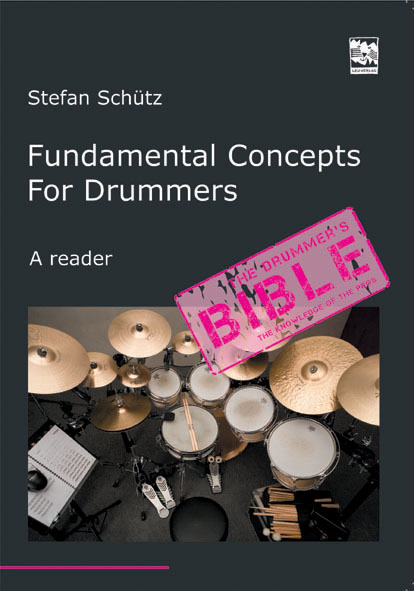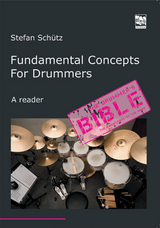Fundamental Concepts for Drummers
Leu-Vlg Wolfgang Leupelt (Verlag)
978-3-89775-127-9 (ISBN)
Stefan Schütz, born 1964, is founder, director, and teacher at the drum department, one of the largest and most successful German drumming schools, based in Stuttgart. He taught at a municipal music school for many years and holds a lectureship at the College of Church Music in Tübingen in the subject field of popular music. He is a graduate of pop music at the Hamburg College of Music and Theater and was teacher and officer of the Landesarbeitskreis Band (regional band task force) in Baden-Württemberg. Besides his activities at the drum department, he is a freelance drummer and producer, conducts band seminars and seminars for private enterprises.
I Acknowledgments 4II Introduction 5II.1 The educational Approach, or, How can he know? 7II.2 Music as a Language 9II.3 Three large Areas 10II.4 The Limits of a Book 11II.5 Sound vs. Artistry – What I pay Attention to 12II.6 Patterns of Thought 14III Technique 15III.1 Technique and Speed, two Sides, one Coin 17III.2 Seeing and Hearing have much in Common 18III.3 Sticks, the Extensions of our Arms 24III.4 Hand Technique 24III.5 Foot Technique 28III.6 Parallelisms, Antagonisms, and other Things 30III.7 Another technical Aspect: The Setup of the Drum Set 32IV Rhythm 35IV.1 What is Rhythm? 35IV.2 Measures 37IV.3 Note Value Tree 38IV.4 Rhythmical Basis of the binary and ternary Structures 38IV.5 Subdivisions which cannot be found in a Book 40IV.6 The hierarchical Structure of applied Rhythmics,or, the End of Correction 43IV.7 Mathematics, or, the Limits of Theory 44
IV.8 Separation of Sounds, or, the End of Parallelity -Horizontal and Vertical Patterns of Thought 45IV.9 Groovy Exercises which enter our Consciousness 47IV.10 Switching off for a Change 48IV.11 The Internal Clock 49IV.12 Another Style, another Basis, or, Why does our Salsa sound so bad? 51IV.13 Pop Music and Classical Music, Folk Music and Techno 54V Stylistics 56V.1 What Parameters we have 56V.2 Orchestration, or, How do I make it sound? 57V.3 Flow Exercises 59V.3 Paradiddles, the underestimated Rudiments 61V.5 Hand-and-Foot Combinations 62V.6 Click 64V.7 Laid Back, Feeling, and the End of Legends 67V.8 Hi-Hat or sounding Meter 69V.9 Grooves 70VI Miscellanea 73VI.1 How many Limbs do we have, actually? 73VI.2 Everything according to Plan 73VI.3 Reading Music and Charts 76VI.4 Musical Styles 78VI.5 Copying allowed and expected 80VI.6 Fill-in Concepts 83VI.7 Improvisation, or, the Art of Talking Freely 85VI.8 Creativity - An Excursion 87VI.9 The Drum Solo 90VI.10 Why always by Oneself? A small Discussion Panel of Two 93VI.11 Odd Times, Metric Modulation, Groove Displacement, and. 94VI.12 What´s my task in a band? 98VI.13 Final Remarks 102
"There are a thousand books showing what to play. The vast majority of drummers don´t more things to play; what they need is to have of clearer picture of how, where and why to play the things they play, in other words, wisdom. Stefan Schuetz´s thought provoking new book clearly adresses these bigger musical questions". John Riley"This is clearly a book which should be part of each drummer's, drum teacher's, and drum school's library. One of the most important publications of the past few years and (.) a unique masterpiece." Sticks Magazine "This is simply a tremendous work." René Creemers "Thoughts about anything which is not put down in a score, for all those who really want to make music." drums & percussion "A must especially for drum teachers." drumheads
I took a long time wondering whether it would make any sense to write yet another book on drumming. The market is fully saturated, and for any conceivable topic you will find more or less sophisticated literature. In the course of my activities as lecturer and director of the drum department, I was granted many really astonishing experiences. I have developed many concepts of my own, some of which are based on the support and suggestions provided by my colleagues. Intensive encounters with some of the world's best drummers have helped me analyze and understand the most various approaches to drumming directly at the source. Realizing the fundamental structures of today's drumming practice has inspired and encouraged me to start this project.In this book I will try to introduce these concepts to the reader. I want to show how people can learn and experience drumming in a way that is different from what is perceived and described in the existing literature on drumming. The whole book is free from any musical notes, because it is not about learning yet another set of licks, patterns, and combinations, but instead a fundamental approach to the instrument we all love to play so much. Some colleagues may consider the one or the other issue from a completely different point of view and tend to a different approach. But that doesn't mean in turn that my concepts are insufficient. They are just different, and they may seem odd in certain respects, but in fact they have been shown to be highly efficient. Many roads lead to Rome, but one definitely doesn't: Following a path and then turning around and going back, then going forth another path, only to return again, and so forth. This would definitely not be recommendable for pursuing a goal. The important thing is to decide for a path and then follow it all the way through. I have made a decision for myself and want to ask the interested reader to join me on this journey, which will lead us to the very core of this instrument, its very substance and basis. It will soon become clear that this is not about abstract ideas and concepts, because the active musician will always remain in focus. A human being with his or her own emotions, conceptions and ways of thinking, with his or her personal traits and individual body awareness. With hopes and joys on the one hand, and fears and insecurities on the other. This is where all the work needs to be aimed at: The very basis. I am sure and have often been assured that the fun you can have with your instrument rises, that the rhythmical skills will improve, and that you will simply sound better as a musician. And that's what it's about for me.All ideas are based on our Western culture and do not raise any claim to be universal applicable. There are completely different rhythm structures in Indian, Arabic, and African regions which I will not expand on. I will focus on those rhythm structures which we find in contemporary popular music, and which contemporary drummers should be able to handle. It goes without saying that only the outlines will be dealt with, and that there are exceptions to each "rule". As a principle, anything that pleases is approved. Every individual is free in his or her personal artistic expression.As far as I am dealing with musical rules and principles, I am actually referring to patterns of listening. There isn't such a thing to our instrument as an academic domain, an absolute doctrine which everybody would be expected to follow, as we know it to be a usual case in the context of empirical science. It is all about the listening habits of fellow-musicians and consumers: That's the standard. Somebody who is not headed at gaining an audience may of course feel free to do whatever he or she likes - there are no borders set to his or her freedom. But those who are striving to improve their drumming according to our listening patterns will certainly find some new approaches for doing so using this book. That's the idea: I want to help us all become better drummers, and I'll be happy to help us all to enjoy our instrument even more. And I am confident that I will succeed.
I took a long time wondering whether it would make any sense to write yet another book on drumming. The market is fully saturated, and for any conceivable topic you will find more or less sophisticated literature. In the course of my activities as lecturer and director of the drum department, I was granted many really astonishing experiences. I have developed many concepts of my own, some of which are based on the support and suggestions provided by my colleagues. Intensive encounters with some of the world's best drummers have helped me analyze and understand the most various approaches to drumming directly at the source. Realizing the fundamental structures of today's drumming practice has inspired and encouraged me to start this project.In this book I will try to introduce these concepts to the reader. I want to show how people can learn and experience drumming in a way that is different from what is perceived and described in the existing literature on drumming. The whole book is free from any musical notes, because it is not about learning yet another set of licks, patterns, and combinations, but instead a fundamental approach to the instrument we all love to play so much. Some colleagues may consider the one or the other issue from a completely different point of view and tend to a different approach. But that doesn't mean in turn that my concepts are insufficient. They are just different, and they may seem odd in certain respects, but in fact they have been shown to be highly efficient. Many roads lead to Rome, but one definitely doesn't: Following a path and then turning around and going back, then going forth another path, only to return again, and so forth. This would definitely not be recommendable for pursuing a goal. The important thing is to decide for a path and then follow it all the way through. I have made a decision for myself and want to ask the interested reader to join me on this journey, which will lead us to the very core of this instrument, its very substance and basis. It will soon become clear that this is not about abstract ideas and concepts, because the active musician will always remain in focus. A human being with his or her own emotions, conceptions and ways of thinking, with his or her personal traits and individual body awareness. With hopes and joys on the one hand, and fears and insecurities on the other. This is where all the work needs to be aimed at: The very basis. I am sure and have often been assured that the fun you can have with your instrument rises, that the rhythmical skills will improve, and that you will simply sound better as a musician. And that's what it's about for me.All ideas are based on our Western culture and do not raise any claim to be universal applicable. There are completely different rhythm structures in Indian, Arabic, and African regions which I will not expand on. I will focus on those rhythm structures which we find in contemporary popular music, and which contemporary drummers should be able to handle. It goes without saying that only the outlines will be dealt with, and that there are exceptions to each "rule". As a principle, anything that pleases is approved. Every individual is free in his or her personal artistic expression.As far as I am dealing with musical rules and principles, I am actually referring to patterns of listening. There isn't such a thing to our instrument as an academic domain, an absolute doctrine which everybody would be expected to follow, as we know it to be a usual case in the context of empirical science. It is all about the listening habits of fellow-musicians and consumers: That's the standard. Somebody who is not headed at gaining an audience may of course feel free to do whatever he or she likes - there are no borders set to his or her freedom. But those who are striving to improve their drumming according to our listening patterns will certainly find some new approaches for doing so using this book. That's the idea: I want to
| Erscheint lt. Verlag | 19.4.2012 |
|---|---|
| Sprache | englisch |
| Maße | 148 x 210 mm |
| Gewicht | 140 g |
| Einbandart | Paperback |
| Themenwelt | Kunst / Musik / Theater ► Musik ► Instrumentenunterrricht |
| Schlagworte | drummers • Drummers studies • Drumming • drumming, mental • drumstudents • drumteachers • Musikalien Rock/Pop/Jazz; Schlagzeug u. Percussion • Schlagzeug |
| ISBN-10 | 3-89775-127-5 / 3897751275 |
| ISBN-13 | 978-3-89775-127-9 / 9783897751279 |
| Zustand | Neuware |
| Haben Sie eine Frage zum Produkt? |
aus dem Bereich




